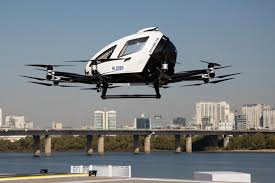The world’s leading Urban Air Mobility (UAM) technology platform company EHang Holdings (Nasdaq: EH) reported a revenue of 456.2 million yuan for 2024, marking a historic high and representing a year-on-year growth of 288.5%. Net loss reached 230 million yuan, narrowing by 23.9% from the previous year.
Non-GAAP adjusted net profit reached 43.1 million yuan, a significant improvement from the adjusted net loss of 138.8 million yuan the previous year.
In Q4 alone, EHang reported a revenue of 164.3 million yuan, also a new record high and marking a 190.2% year-on-year increase and a 28.2% quarter-on-quarter growth. The net loss for Q4 was 46.9 million yuan, a 35.3% improvement over the previous year. Non-GAAP adjusted net profit was 36.4 million yuan, compared to a loss of 22.1 million yuan in the same quarter last year, marking the third consecutive quarter of Non-GAAP adjusted profitability.
EHang achieved positive operating cash flow for the fifth consecutive quarter and became the first eVTOL (electric vertical takeoff and landing) company globally to achieve profitability and positive cash flow for the year, marking a significant milestone in the company’s 10-year development, the company said.
In Q3 of 2024, EHang received over $22 million in PIPE (Private Investment in Public Equity) strategic investment from Inboor and a Middle Eastern strategic investment institution. The company’s total smart financing reached nearly $100 million last year, with cash reserves exceeding 1.1 billion yuan, generating positive cash flow for the entire year, it said.
This year, EHang plans to raise additional funds to support new product development, market expansion, the expansion of production bases in various locations, and the expansion of its team.
Record Sales and Deliveries
The flagship product EH216-S was the main revenue source. In April, EHang became the first eVTOL company globally to obtain all three essential certifications—Production Certificate (PC), Type Certificate (TC), and Standard Airworthiness Certificate (AC). In July, its wholly-owned subsidiary focused on UAM operations, EHang Urban Air Mobility, and its low-altitude economy operation subsidiary in Hefei, HeYi Aviation, submitted their Operation Certification (OC) applications to the Civil Aviation Administration of China (CAAC), which was the world’s first eVTOL OC application project.
EHang’s annual sales and deliveries of EH216 series unmanned aerial vehicles (UAVs) hit a historic high last year, with 216 units sold and delivered, a 315.4% surge from 52 units in 2023, and in Q4 alone, it sold and delivered 78 units.
To meet growing demand, EHang is working to boost production efficiency and expand its manufacturing capacity. The company is planning to establish regional production bases in Southern, Eastern, and Northern China.
EHang’s Yunfu production base in Southern China is set to expand by 24,000 square meters and aims to double its original production capacity, targeting an annual output of 1,000 units by the end of 2024, the company said. In addition, EHang is working with Jianghuai Automobile and Guoxian Holdings to establish a joint venture in Hefei, focusing on eVTOL production, and with Weihai High-tech Zone to set up a manufacturing hub in Shandong Province.
Revenue Diversification Expected in 2025
“We believe the next decade will see the boom of the low-altitude economy and the rapid development of AI and autonomous aviation,” said EHang’s Founder, Chairman, and CEO, Hu Huazhi.
In 2025, EHang plans to continue deepening its “AI+” strategy, integrating AI technology into the full lifecycle of eVTOLs and their commercial operations, which is expected to accelerate the construction of digital infrastructure for air traffic, he said.
Regarding technical breakthroughs and product development, EHang completed the world’s first eVTOL flight using solid-state lithium batteries, doubling the flight range of the EH216-S. The company is also focusing on fast-charging batteries, with sample units already being tested. In addition, it’s assembling prototype long-range aircraft and plans to complete full-function test flights and initiate flight certification processes in the near future.
“If 2024 is the year for low-altitude planning, then 2025 will be the year for low-altitude implementation. We look forward to the early issuance of two OC certificates, marking the beginning of the eVTOL commercial operation era,” said Hu.
Since EHang obtained its three aviation certificates, it has been continuously pushing for the commercialization and operational implementation of the EH216-S. To date, customers have established more than 20 EHang eVTOL operation demonstration points and take-off/landing sites across 16 cities in China, including Hefei, Guangzhou, Shenzhen, Shanghai, Wuxi, Taiyuan, and Wenzhou. This year, EHang aims to take the lead in building operational demonstration projects in these key cities, allowing the general public to truly experience eVTOL flight services.
Regarding the commercialization of air taxis, COO Wang Zhao said that safety is the top priority in the aviation industry and the air taxi scenario requires a careful, step-by-step approach.
Over the next two years, EHang plans to pilot services at tourist destinations, accumulating sufficient safety operation data before transitioning to urban air taxi services, and the company is also involved in designing and building urban air traffic hubs and digital infrastructure to support air taxis, he said.
Wang highlighted that the commercialization of eVTOLs will open up multiple revenue streams for EHang, and i addition to passenger services, the company plans to expand into logistics, emergency rescue services, product sales, customer training, spare parts sales, maintenance, software systems, takeoff/landing point designs, and flight route operations.
For 2025, the management expects to generate 900 million yuan in revenue, a 97% year-on-year surge, and achieve GAAP profitability in Q3 2025 and to reach full-year GAAP profitability in 2026. Capital expenditures for 2025 are projected to be approximately USD 40 million, primarily for capacity expansion, while operational expenses are expected to grow by around 40%.

